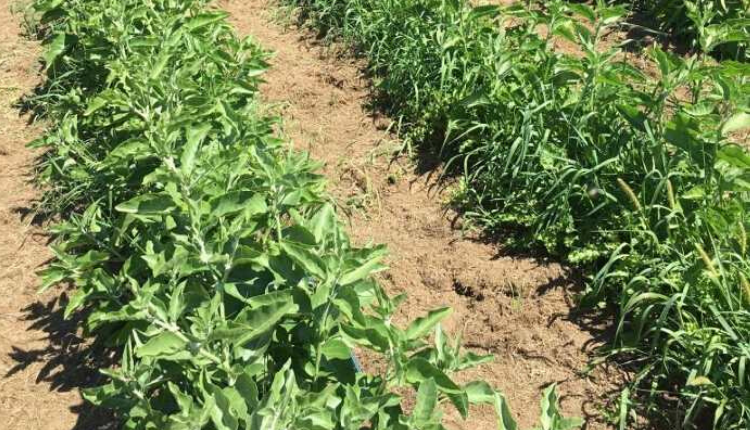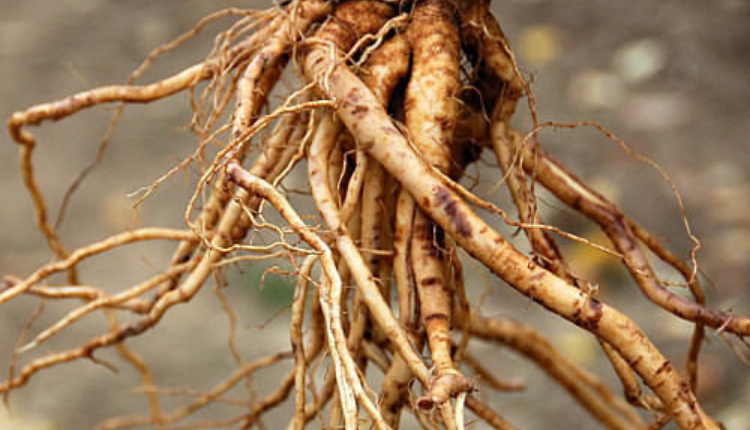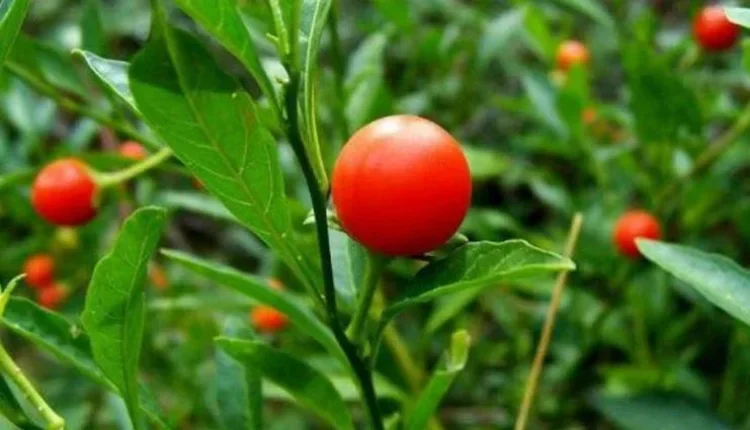Good income on barren land with Ashwagandha Cultivation
The main yield in the cultivation of Ashwagandha may be its roots, but everything about it gives profit
Ashwagandha cultivation is a great option if there is an intention to earn good income at low cost even from less fertile and irrigated land. Ashwagandha is a medicinal and cash crop. It can be cultivated in irrigated and unirrigated and all types of land. Not only can it be adopted as a crop rotation, but it is also ideal for land where irrigation water is somewhat saline and the climate is dry or semi-arid because salt water irrigation can lead to useful elements found in Ashwagandha, i.e. ‘alkaloids’ increases by two to two and a half times.
The botanical name of Ashwagandha is Withania somnifera. It doesn’t get sick quickly. Nor does it require chemical fertilizers. Stray animals also do not harm it. That is why the farmers cultivating Ashwagandha are rest assured on many fronts. That is why agricultural experts say that such land is most suitable for Ashwagandha where it is very difficult to get other profitable crops. The main yield in the cultivation of Ashwagandha may be its roots, but everything about it gives profit. Ashwagandha plants, leaves and seeds, etc., get the price for everything.
Ashwagandha demand in the country
Ashwagandha is cultivated in about 5000 hectares in the country. Its annual yield is about 1600 tonnes, while the demand is 7000 tonnes. That is why farmers do not face any problem in getting good price of Ashwagandha in the market. This plant is found in all other parts except the cold regions. But its cultivation is abundant in Mandsaur, Neemuch, Manasa, Javad, Bhanpura of western Madhya Pradesh and Nagaur district of nearby Rajasthan. Nagori Ashwagandha also has a different identity in the market.
Use of ashwagandha
Ashwagandha is used as medicine. Many Ayurvedic and Unani medicines are made from its dried roots. Its consumption removes stress and anxiety. It increases the immunity of the body and strengthens the nervous system. It makes medicines for diseases like paralysis, spinal and urinary problems, rheumatism, cancer, sexual enhancer, skin diseases, inflammation in lungs, stomach ulcers, worms and heartburn, back pain, knee swelling, tuberculosis and eye diseases. Ashwagandha is also used extensively in making Chyawanpras.

Ashwagandha’s roots and leaves contain 0.13 to 0.51 percent of many alkaloids. Its major alkaloids are – withanine (sedative), bethenene, withaferin (antitumor), withaferin-A (antibacterial) somnine, choline, nicotine and somniferin. Apart from this, glycosides, vitamins, starch, sugar and amino acids are also found in Ashwagandha.
How To Cultivate Ashwagandha?
Ashwagandha can be cultivated twice a year. Once under Rabi in February-March and second time as Kharif in August-September. Wheat can also be taken after the Kharif Ashwagandha in the crop rotation. Ashwagandha crop is ready in about 5 months. The main product of Ashwagandha is its root. For its good growth, dry and semi-arid weather with rainfall of 500 to 700 mm and temperature should be around 35 °C.
Ashwagandha seed
The height of the Ashwagandha plant ranges from 40 to 150 cm. Its stem is branched, erect, gray or white hairy. Its roots are long and oval. Its flowers are green or yellow in colour and the fruits are about 6 mm round, smooth and red in colour. There are many seeds in each fruit. The varieties of Ashwagandha named ‘Poshita’ and ‘Rhitata’, developed by the Central Medicinal and Aromatic Research Institute, Lucknow, are very good for infertile and dry areas. Its price is around Rs 200 per kg.
Ashwagandha sowing
Ashwagandha can be sown in both ways. By sprinkling seeds or by transplanting nursery grown plants. Sowing in nursery should be done in June-July. Sowing of rainfed crop can be done by directly sprinkling the seeds in the field. In irrigated crop, keeping a distance of one feet between the rows of plants and 5 to 10 cm distance between two plants gives good yield and also helps in weeding.

Ashwagandha Crop Protection
Before sowing Ashwagandha seeds should be treated with Thiram or Dithane M-45 @ 3 g/kg solution. To protect its roots from nematode disease, at the time of sowing, at the rate of 5-6 kg furadan per hectare should be mixed in the field. Leaf rot (seedling blast) and leaf spot are common diseases of Ashwagandha, which reduce the number of plants in the field. Therefore, before sowing the seeds should be treated with Thiram or Dithane M-45 @ 3 g/kg solution.
A nursery of 5 kg seed is suitable for one hectare. Germination of seeds occurs in 8-10 days. When the nursery plants are 4 to 6 cm high, they should be planted in rows of one foot at a distance of 5 to 10 cm. One month old crop should be sprayed after mixing Diethene M-45 at 3 grams per litre of water at an interval of 7-10 days till the disease is controlled. To keep the crops safe from leaf-eater insects, spray this solution 2-3 times by mixing 5-6 ml of a drug called Rogar or Nuan in one litre of water.
Fertilizer and weeding
Ashwagandha is a root crop, so regular weeding gives air to the roots and gives more yield. After 20-25 days of direct sowing, weeding should be done by balancing the distance of the plants. For better development of the roots of Ashwagandha, before sowing only cow dung manure or 15 kg nitrogen per hectare gives more yield. After this the crop does not need any other fertilizer.
Ashwagandha irrigation
Ashwagandha requires less irrigation, so if Ashwagandha is cultivated in fertile and irrigated land, then there should be a good drainage system. If the rainfall is regular then there is no need to water the crop. Irrigate after rain only when the field starts drying up. Irrigation of Ashwagandha with salt water of 4 to 12 EC (electrical conductivity) increases its quality by 2 to 2.5 times, as its salt tolerance is up to 16 EC. Let us tell you that salt tolerance is considered an important measure of soil health.
Ashwagandha Digging, Drying and Storage
Ashwagandha crop is ready for digging in 135 to 150 days. When the leaves of the plant turn yellow, the crop is ready for digging. At the time of digging the entire plant should be uprooted along with the root. Then the roots should be cut from the plants and washed with water and dried in the sun. After drying the roots should be sorted according to their size.
Ashwagandha with 6-7 cm long, one-and-a-half cm thick, shiny and white root is considered to be the best category. After this, 5 cm long and one cm thick roots are placed in the second level and 3-4 cm long roots are placed in the third level and after that the remaining chopped and thin roots are kept in the last category. After pruning, the roots can be easily stored in jute sacks in a ventilated and termite-free place for a year or sold in the market.

Ashwagandha Cost, Yield and Profit
Apart from the roots of Ashwagandha, its seeds and the straw of the uprooted plants from the field are also sold in the market. According to the quality, roots and seeds are sold for Rs 150 to 200 per kg, while the straw of the tree also fetches a price of about Rs 15 per kg.
Generally, 7-8 quintals of fresh roots are obtained from the cultivation of Ashwagandha in one hectare. On drying, 4-5 quintals remain. Apart from this, about 50-60 kg of seed is also obtained. The cost of cultivation of Ashwagandha is around 10-12 thousand rupees per hectare (2.5 acres). While the produce is sold for around Rs 75-80 lakh. That is, a profit of 6-7 times the cost. The benefits of Ashwagandha cultivation of improved species can be more.
Contact us: If farmers want to share information or experiences related to farming with us, then they can do this by calling us on the phone number 9599273766 or by writing an email to [email protected] or by sending your recording. Through Kisan of India, we will convey your message to the people, because we believe that if the farmers are advanced then the country is happy.
You can connect with Kisan of India on Facebook, Twitter, and Whatsapp and Subscribe to our YouTube channel.



